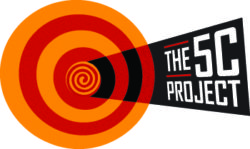At this very moment I am going through the notes I took while listening to this masterclass and I must admit I really haven’t written a lot. One of the reasons was my after-lunch sleepiness. The second reason is that this was more of an interactive than classic listen-and-write-it-down type of masterclass.
The masterclass was held in Booze Cooperativa – amazing place covered in graffiti, old-fashioned and modern at the same time. The place was packed – it was nice to see so many festival participants, volunteers and local students interested in film.
Every movie has so many different aspects and layers. I started my academic exploration of movies just three years ago and I am mostly focused on screenwriting in theory and praxis – you can bet I am not that familiar with the secrets of the cinematography aspect yet. Olympia’s masterclass was great for cinematography newbies like me.
So, what have I learned? Let’s start from my understanding of the title of this masterclass – Writing in Light – as I believe it is a good illustration of Olympia’s entire lecture. It suggests that cinematography is a kind of meta-language, having its own means of expression instead of words and, of course, having its own grammar. (Stay with me, I promise this won’t be tiresome as the regular grammar) Olympia has introduced us to the three basic types of cinematography which could be understood as the basic ‘grammar’ of cinematography. Each type is used for certain stories and situations. For example, when it comes to poetic scenes, a cinematographer becomes a painter and makes frames looking like paintings.
Right after that, I’ve realized how the cinematographer overcomes the grammar of cinematography – by breaking its rules, of course. The principle is the same as in the progress of every other movie aspect – modify the rule, break it or forget it, make things eclectic and exciting, but keep them understandable.
For me, the easiest way to understand cinematography was through screenwriting and writing critiques. We write using words, cinematographer writes using numerous other means – but basically, it is a similar process, where we search for the right word/mean to express a certain emotion. Screenwriter’s words become more powerful when the proper light is used. Critic’s impressions are different in front of a different cinematography work. The cinematographer seeks for the inspiration in screenwriter’s words and the screenwriter’s words are incomplete without the proper cinematography.
One of the most interesting films shown during this year’s altcineAction was “Annie” by Bulgarian author Iliyan Kyuchukov. In this film, the viewer’s position is equalized with the position of the protagonist who films everything with her camera. The result is very shaky and dynamic – some may say even aggressive camerawork. Actually, the camerawork follows the narrative and the subject perfectly. The violence pulsates and vibrates as the camera moves. Mobile camera, as a meta-film mean, also gives viewer a certain feeling of reality, as there is a minimum of cinematic stylization used in this film’s cinematography approach. Finally, it emphasizes the dangers and insecurities present in the depicted world. In terms of technology, this approach may be cheap, but in terms of its effects, I find it priceless.

